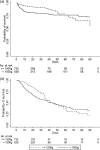Late-onset sepsis and mortality among neonates in a Brazilian Intensive Care Unit: a cohort study and survival analysis
- PMID: 31364533
- PMCID: PMC6624867
- DOI: 10.1017/S095026881900092X
Late-onset sepsis and mortality among neonates in a Brazilian Intensive Care Unit: a cohort study and survival analysis
Abstract
A cohort study was performed from January 2014 to December 2016 in a Brazilian neonatal intensive care unit, including neonates with high risk for infection and death. We estimated bloodstream infection (BSI) incidence and conducted a survival analysis, considering the time to death and to the first episode of BSI as outcomes, comparing very low birth weight (VLBW) neonates with the remaining neonates. An extended Cox model was performed and the hazard ratio (HR) was calculated for different time periods. The study had 1560 neonates included, the incidence and the incidence density of BSI was 22% and 18.6 per 1000 central venous catheter-days, respectively. Considering VLBW neonates as the reference group, the HR for time to death was 4.06 (95% CI 2.75-6.00, P < 0.01) from day 0 to 60 and for time to the first episode of BSI was 1.76 (95% CI 1.31-2.36, P < 0.01) from day 0 to 36. Having the heavier neonates group as reference, the HR for time to the first episode of BSI was 2.94 (95% CI 1.92-4.34, P < 0.01) from day 37 to 90. Late-onset neonatal sepsis prevention measures should consider the differences in risk during time, according to neonates' birth weight.
Keywords: Brazil; healthcare-associated infections; late-onset neonatal sepsis; survival analysis; very low birth weight infants.
Conflict of interest statement
None.
Figures
Similar articles
-
Selenium Supplementation for Prevention of Late-Onset Sepsis in Very Low Birth Weight Preterm Neonates.J Trop Pediatr. 2016 Jun;62(3):185-93. doi: 10.1093/tropej/fmv096. Epub 2016 Feb 10. J Trop Pediatr. 2016. PMID: 26867560 Clinical Trial.
-
Incidence, clinical features, and implications on outcomes of neonatal late-onset sepsis with concurrent infectious focus.BMC Infect Dis. 2017 Jul 3;17(1):465. doi: 10.1186/s12879-017-2574-7. BMC Infect Dis. 2017. PMID: 28673280 Free PMC article.
-
Evaluation of the Neonatal Sequential Organ Failure Assessment and Mortality Risk in Preterm Infants With Late-Onset Infection.JAMA Netw Open. 2021 Feb 1;4(2):e2036518. doi: 10.1001/jamanetworkopen.2020.36518. JAMA Netw Open. 2021. PMID: 33538825 Free PMC article.
-
[Neonatal sepsis: epidemiologic indicators and relation to birth weight and length of hospitalization time].An Esp Pediatr. 1998 Apr;48(4):401-8. An Esp Pediatr. 1998. PMID: 9629800 Review. Spanish.
-
Global incidence and mortality of neonatal sepsis: a systematic review and meta-analysis.Arch Dis Child. 2021 Jul 19;106(8):745-752. doi: 10.1136/archdischild-2020-320217. Arch Dis Child. 2021. PMID: 33483376 Free PMC article.
Cited by
-
Time to death and its predictors among neonates admitted with sepsis in neonatal intensive care unit at comprehensive specialized hospitals in Northeast Ethiopia.Front Pediatr. 2024 Apr 17;12:1366363. doi: 10.3389/fped.2024.1366363. eCollection 2024. Front Pediatr. 2024. PMID: 38711492 Free PMC article.
-
Treatment outcomes and its associated factors among neonates admitted with sepsis in Hiwot Fana Comprehensive Specialized University Hospital, Harar, Ethiopia.Front Pediatr. 2025 Jan 21;12:1434803. doi: 10.3389/fped.2024.1434803. eCollection 2024. Front Pediatr. 2025. PMID: 39911769 Free PMC article.
-
Neonatal healthcare-associated infections in Brazil: systematic review and meta-analysis.Arch Public Health. 2021 Jun 1;79(1):89. doi: 10.1186/s13690-021-00611-6. Arch Public Health. 2021. PMID: 34074325 Free PMC article. Review.
-
Neonatal sepsis in Iran: A systematic review and meta-analysis on national prevalence and causative pathogens.PLoS One. 2020 Jan 24;15(1):e0227570. doi: 10.1371/journal.pone.0227570. eCollection 2020. PLoS One. 2020. PMID: 31978069 Free PMC article.
-
One year cross-sectional study in adult and neonatal intensive care units reveals the bacterial and antimicrobial resistance genes profiles in patients and hospital surfaces.PLoS One. 2020 Jun 3;15(6):e0234127. doi: 10.1371/journal.pone.0234127. eCollection 2020. PLoS One. 2020. PMID: 32492060 Free PMC article.
References
-
- Brazilian Ministry of Health (2015) Saúde Brasil 2014: uma análise da situação de saúde e das causas externas, 1st Edn. Brasília: Ministério da Saúde.
-
- Darmstadt GL, Zaidi AKM and Stoll BJ (2011) Neonatal infections: a global perspective In Remington JS and Klein JO (eds), Infectious Diseases of the Fetus and Newborn Infant, 7th Edn. Philadelphia: Elsevier Saunders, pp. 24–51.
-
- Inter-Agency Health Information Network (RIPSA). Proporção de partos hospitalares. Available at http://tabnet.datasus.gov.br/cgi/tabcgi.exe?idb2012/f07.def (Accessed 31 March 2017).
-
- Stoll BJ and Hansen N (2003) Infections in VLBW infants: studies from the NICHD Neonatal Research Network. Seminars in Perinatology 27, 293–301. - PubMed
MeSH terms
LinkOut - more resources
Full Text Sources


